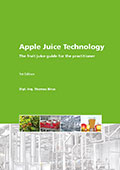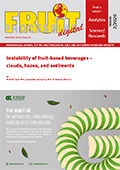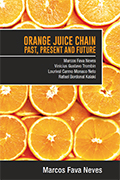Tate & Lyle and Cryptobiotix’s breakthrough ex-vivo* study shows that sucralose does not impact the gut microbiota, while other low and no calorie sweeteners have potentially beneficial health effects
A new, first-of-its-kind study has identified unique and potentially beneficial interactions between certain low and no calorie sweeteners, including stevia, and the human gut microbiota. Tate & Lyle PLC, a world leader in ingredient solutions for healthier food and drink, partnered with Cryptobiotix, pioneers in preclinical gastrointestinal research, on the study.
Dr. Davide Risso, molecular biology specialist and Tate & Lyle’s Head of Nutrition Research, led the project to explore the potential impact of certain low and no calorie sweeteners on the gut environment in both healthy individuals and those with type 2 diabetes. The research involved taking samples from co-living adults consuming a similar diet – to lower the potential variation introduced by differences in long-term diet, a major driver of microbiota composition. The doses of low and no calorie sweeteners used were based on actual intakes, regulations and amounts that are generally included in foods and beverages during different timepoints.
Results from the pre-clinical study, published in the leading peer reviewed, open-access journal the International Journal of Food Sciences and Nutrition, found that some of the studied low calorie and no calorie sweeteners had no impact on the gut microbiota, while others had potential beneficial health effects.
Using Cryptobiotix’s cutting-edge SIFR® (“cipher”) technology to recreate the gut environment outside of the human body, the research partners found that sweeteners, such as sucralose, do not impact the microbial composition of the gut. Furthermore, other sweeteners, including stevia, have a beneficial impact on the gut microbiota as they were found to be easily fermented and increase the density of certain health-supporting bacteria, with the production of short-chain fatty acids.
The study adds to the strong scientific evidence demonstrating the beneficial role low and no calorie sweeteners can play when used as a part of a balanced diet. Assessments of additional low and no calorie sweeteners, including allulose and erythritol, are being completed and details will be shared in due course.
Dr. Davide Risso, Tate & Lyle’s Head of Nutrition Research, said:
“In this study, the low and no calorie sweeteners we have assessed are shown to have either no impact on the gut microbiota or to offer potential health benefits beyond their established sugar and calorie reduction benefits. Human clinical trials will be required to confirm the potential health benefits. At Tate & Lyle, we’re committed to advancing understanding around the role of low and no calorie sweeteners in the diet and sharing knowledge in this emerging field as a purpose-led, science-driven company.”
Dr Pieter Van den Abbeele, Cryptobiotix’s Chief Scientific Officer, said:
“Cryptobiotix was founded with the ambition of providing accurate insights into the impact and behaviour of ingredients in relation to the gut microbiome. This study provides much-needed evidence to consider the potential benefits of sweeteners individually, rather than as a uniform whole. The robustness and validation work that went into the SIFR® technology used, allowed us to pinpoint specific health-promoting pathways in relation to specific low and no calorie sweeteners.”
*In ex vivo studies, living tissues are directly taken from a living organism and studied in a laboratory with minimal alterations to the organism’s natural conditions.
Royal Unibrew A/S announced the closing of the acquisition of Vrumona, the second largest soft drink company in the Netherlands, from Heineken. Vrumona is located near Utrecht and employs more than 300 people. The company has a strong portfolio of own brands and partner brands supporting the health and sustainability agenda.
Lars Jensen, CEO of Royal Unibrew A/S, states: “I am happy to welcome the dedicated and talented people from Vrumona to the Royal Unibrew family. We are eager to onboard the strong organisation and get started on the exiting journey to establish the company as a multi-beverage platform in Central Europe that will deliver organic earnings growth for years to come.”
As previously announced, Royal Unibrew A/S is acquiring 100 % of Vrumona at an enterprise value of EUR 300 million on a debt free basis. In 2022, Vrumona realised net revenue of EUR 200 million and an EBITDA of around EUR 25 million, resulting in an acquisition multiple (EV/EBITDA) of 12x.
The acquisition is expected to be EPS accretive in 2024, and ROIC on the acquisition is expected to exceed WACC within three years.
Vrumona fits very well into Royal Unibrew A/S’ operating model of strong local businesses with strong local brands with its solid positions in On-Trade and Off-Trade. The company has been a front runner in creating healthy and functional beverages for years for which reason the majority of its business is within the no/low sugar and calories segment. With the acquisition, Royal Unibrew A/S establish a new growth platform and expand its geographical footprint while the company also expand its longstanding relationship with PepsiCo as Vrumona is operating the full beverage portfolio from PepsiCo on a license agreement in a partnership dating back to 1949.
The Vrumona production facility in Bunnik includes seven lines with a current annual output of around 3.1 million hectoliters. The production facility is in a good condition; however, additional long-term investments are needed to improve efficiency as well as to expand capabilities and capacities. It is therefore expected that it will take some years before the platform is able to exploit its full organic growth potential.
Young Indian beer lovers are leading the way in responsible beer consumption, as the latest research from Mintel highlights that more than two in five (41 %) Indian beer drinkers aged 25 – 34 say they are interested in switching from standard strength beer to low/no alcohol (LNA) versions.
While alcohol moderation is becoming more pronounced among Indians as a whole, with an average of 38 % of Indian beer consumers* interested in switching to low/no alcohol versions, the over 45s (32 %) are less enthusiastic about making this switch.
The top three barriers for beer consumption among Indian consumers include health reasons (48 %), to avoid getting drunk (35 %) and to avoid hangovers (31 %).
Natasha Kumar, Mintel Food and Drink Analyst, India, said: “Responsible and healthy drinking has become the mantra amongst young Indians today. While this behaviour is seen across all age groups with Indians showing interest in LNA beer, it is more noticeable amongst young consumers aged 25-34 years. Brands need to explore opportunities around reduced or no alcohol options since this consumer group makes up a significant majority of beer drinkers in the country. With the current pandemic causing consumers to be even more conscious about their health and diet, the LNA category is expected to grow further post the lockdown. It also offers brands the opportunity to connect with health-conscious and responsible beer drinkers, which will prevent them from dropping out of the beer category entirely.”
Indian beer lovers are watching their waistlines
Shining a spotlight on health and wellbeing, Mintel research highlights that many Indian consumers are interested in trying low-calorie (43 %) and gluten-free (32 %) beer. In fact, over a third of consumers (34 %) say low-calorie content is an important factor when purchasing beer.
“As consumers claim that health is a key deterrent for regular beer consumption, the opportunity lies in expanding beer offerings with healthier profiles addressing concerns surrounding health. Low-calorie, low-carb and gluten-free beers can all appeal to this consumer need. As one of the largest producers of millet in the world, Indian brewers can turn towards this unconventional grain to cater to consumer demand. Countries such as Norway and Spain can act as good reference points for Indian brands to take inspiration for gluten-free beer. Diversifying the portfolio will help brands to expand consumer base to those health-conscious consumers,” continues Natasha Kumar.
Packaging innovations in craft beer can cater to the masses
Finally, Mintel research highlights that the most preferred type of beer includes lager (63 %) and wheat beer (51 %). In addition, craft beer is consumed by almost half of Indian consumers (45 %) and is perceived to be of high quality and worth a premium price, as three in four consumers (75 %) agree that it is worth paying more for it over mainstream beer.
“The popularity of lager and wheat beer indicate that lighter beers are more suitable to the Indian palate. For craft beer to appeal to a larger population of consumers, brands should innovate and introduce more craft beer varieties in lager, ale and wheat beer. One of the main benefits of craft beer is that consumers perceive it is better quality and as such, they are willing to pay more for it. Brands can premiumise their brand portfolio by adding craft beers to target consumers who are willing to pay extra. Craft beer was gaining significant traction in the country, however, the lockdown has caused pubs/microbreweries to shut, limiting the majority of craft beer sales. Bottling/canning could be the next step for craft beer brands, ensuring it reaches consumers with wider distribution, retail stocking and relatively longer shelf life.” concludes Natasha Kumar.
*1,655 Indian internet users aged 25+ who have drunk beer in the past six months
Clean and clear labeling concerns are now well established in the food and beverage industry, having featured as a key and running theme through all Innova Market Insights’ Top Trends forecasts in recent years. More than ten years ago ‘Go Natural’ led the Company’s annual top trends listing and since then clean label claims have developed and featured each year in different forms, increasingly weaving throughout the entire trends listings until they are now regarded as a given.
The term ‘clear labeling,’ which Innova Market Insights coined for its 2015 trends listing, has now fully entered industry parlance, being used in several company marketing campaigns, with new commitments on a clean or clear platform regularly.
Its increasingly mainstream status is illustrated in the fact that nearly 28 % of global food and beverage launches recorded by Innova Market Insights in 2018 used one or more clean label claims (natural, organic, no additives/preservatives and GMO-free), rising to nearly 39 % in the US.
There have also been associated rises in interest in related clean label areas such as vegan-friendly, raw and paleo diets, and also in the focus on minimal processing, including the use of techniques such as cold-pressing and high-pressure treatment. This is running alongside increasingly wide ethical concerns, including fair trade and sustainability, packaging, the environment, and animal welfare.
No additives/preservatives claims continue to feature most strongly, used for just over 15 % of global launches in 2018, rising to over 20 % in the US. The US generally sees higher levels of use of all types of clean label positionings and is also particularly notable for the strong position of GMO-free labeling. This featured on 17.8 % of launches, compared with under 6 % globally and was also the number two clean label claim in the US overall, well ahead of both organic on just over 13 % and natural on just over 8 %.
Flavor is still the number one factor influencing purchasing decisions, reports Lu Ann Williams, Director of Innovation at Innova Market Insights. “But it is clear that in recent years, the clean label trend has broadened out into a wider movement, focusing on an increasingly mindful consumer trying to make responsible food choices that are not only tasty and healthy but also sustainable and ethical.”
While interest in clean label has kept organic and GMO free claims in the spotlight in many countries, rising levels of competition mean that product offerings have had to become much more sophisticated, focusing more on value-added products and combining both specialist organic brands and organic and GMO free variants in existing conventional ranges.
Organic or GMO claims alone may not now be enough and companies are focusing on additional benefits including other related clean-label areas such as vegan-friendly, raw, and paleo diets, as well as local ingredients and sourcing, minimal processing and unusual and premium-style recipes and flavors, including the use of seasonal and limited editions.









